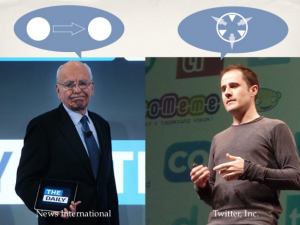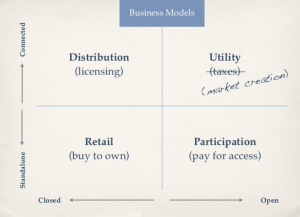The recent blog frenzy over hyperlocal media inspired me to have a look at Outside.in again.

It’s not just the high profile backers and the intense competitive set that make Outside.in worth a second look. There’s something very compelling in the way they are connecting data that seems like it matters.
My initial thought when it launched was that this idea had been done before too many times already. Topix.net appeared to be a dominant player in the local news space, not to mention similar but different kinds of local efforts at startups like Yelp and amongst all the big dotcoms.
And even from their strong position, Topix’s location-based news media aggregaton model was kind of, I don’t know, uninteresting. I’m not impressed with local media coverage these days, in general, so why would an aggregator of mediocre coverage be any more interesting than what I discover through my RSS reader?
But I think Outside.in starts to give some insight into how local media could be done right…how it could be more interesting and, more importantly, useful.
The light triggered for me when I read Jon Udell’s post on “the data finds the data”. He explains how data can be a vector through which otherwise unrelated people meet eachother, a theme that continues to resonate for me.
Media brands have traditionally been good at connecting the masses to eachother and to marketers. But the expectation of how directly people feel connected to other individuals by the media they share has changed.
Whereas the brand once provided a vector for connections, data has become the vehicle for people to meet people now. Zip code, for example, enables people to find people. So does marital status, date and time, school, music taste, work history. There are tons of data points that enable direct human-to-human discovery and interaction in ways that media brands could only accomplish in abstract ways in the past.
URLs can enable connections, too. Jon goes on to explain:
“On June 17 I bookmarked this item from Mike Caulfield… On June 19 I noticed that Jim Groom had responded to Mike’s post. Ten days later I noticed that Mike had become Jim’s new favorite blogger.
I don’t know whether Jim subscribes to my bookmark feed or not, but if he does, that would be the likely vector for this nice bit of manufactured serendipity. I’d been wanting to introduce Mike at KSC to Jim (and his innovative team) at UMW. It would be delightful to have accomplished that introduction by simply publishing a bookmark.”
Now, Outside.in allows me to post URLs much like one would do in Newsvine or Digg any number of other collaborative citizen media services. But Outside.in leverages the zip code data point as the topical vector rather than a set of predetermined one-size-fits-all categories. It then allows miscellaneous tagging to be the subservient navigational pivot.
Suddenly, I feel like I can have a real impact on the site if I submit something. If there’s anything near a critical mass of people in the 94107 zip code on Outside.in then it’s likely my neighbors will be influenced by my posts.
Fred Wilson of Union Square Ventures explains:
“They’ve built a platform that placebloggers can submit their content to. Their platform “tags” that content with a geocode — an address, zip code, or city — and that renders a new page for every location that has tagged content. If you visit outside.in/10010, you’ll find out what’s going on in the neigborhood around Union Square Ventures. If you visit outside.in/back_bay, you’ll see what’s going on in Boston’s Back Bay neighborhood.”
Again, the local online media model isn’t new. In fact, it’s old. CitySearch in the US and UpMyStreet in the UK proved years ago that a market does in fact exist in local media somehwere somehow, but the market always feels fragile and susceptible to ghost town syndrome.
Umair Haque explains why local is so hard:
“Why doesn’t Craigslist choose small towns? Because there isn’t enough liquidity in the market. Let me put that another way. In cities, there are enough buyers and sellers to make markets work – whether of used stuff, new stuff, events, etc, etc.
In smaller towns, there just isn’t enough supply or demand.”
If they commit to building essentially micro media brands based exclusively on location I suspect Outside.in will run itself into the ground spending money to establish critical mass in every neighborhood around the world.
Now that they have a nice micro media approach that seems to work they may need to start thinking about macro media. In order to reach the deep dark corners of the physical grid, they should connect people in larger contexts, too. Here’s an example of what I mean…
I’m remodeling the Potrero Hill shack we call a house right now. It’s all I talk about outside of work, actually. And I need to understand things like how to design a kitchen, ways to work through building permits, and who can supply materials and services locally for this job.
 There must be kitchen design experts around the world I can learn from. Equally, I’m sure there is a guy around the corner from me who can give me some tips on local services. Will Architectural Digest or Home & Garden connect me to these different people? No. Will The San Francisco Chronicle connect us? No.
There must be kitchen design experts around the world I can learn from. Equally, I’m sure there is a guy around the corner from me who can give me some tips on local services. Will Architectural Digest or Home & Garden connect me to these different people? No. Will The San Francisco Chronicle connect us? No.
Craigslist won’t even connect us, because that site is so much about the transaction.
I need help both from people who can connect on my interest vector in addition to the more local geographic vector. Without fluid connections on both vectors, I’m no better off than I was with my handy RSS reader and my favorite search engine.
Looking at how they’ve decided to structure their data, it seems Outside.in could pull this off and connect my global affinities with my local activities pretty easily.
This post is way too long already (sorry), but it’s worth pointing out some of the other interesting things they’re doing if you care to read on.
Outside.in is also building automatic semantic links with the contributors’ own blogs. By including my zip code in a blog post, Outside.in automatically drinks up that post and adds it into the pool. They even re-tag my post with the correct geodata and offer GeoRSS feeds back out to the world.
Here are the instructions:
“Any piece of content that is tagged with a zip code will be assigned to the corresponding area within outside.in’s system. You can include the zip code as either a tag or a category, depending on your blogging platform.”
I love this.
30Boxes does something similar where I can tell it to collect my Upcoming data, and it automatically imports events as I tag them in Upcoming.
They are also recognizing local contributors and shining light on them with prominant links. I can see who the key bloggers are in my area and perhaps even get a sense of which ones matter, not just who posts the most. I’m guessing they will apply the “people who like this contributor also like this contributor” type of logic to personalize the experience for visitors at some point.
Now what gets me really excited is to think about the ad model that could happen in this environment of machine-driven semantic relationships.
If they can identify relevant blog posts from local contributors, then I’m sure they could identify local coupons from good sources of coupon feeds.
 Let’s say I’m the national Ace Hardware marketing guy, and I publish a feed of coupons. I might be able to empower all my local Ace franchises and affiliates to publish their own coupons for their own areas and get highly relevant distribution on Outside.in. Or I could also run a national coupon feed with zip code tags cooked into each item.
Let’s say I’m the national Ace Hardware marketing guy, and I publish a feed of coupons. I might be able to empower all my local Ace franchises and affiliates to publish their own coupons for their own areas and get highly relevant distribution on Outside.in. Or I could also run a national coupon feed with zip code tags cooked into each item.
To Umair’s point, that kind of marketing will only pay off in major metros where the markets are stronger.
To help address the inventory problem, Outside.in could then offer to sell ad inventory on their contributors’ web sites. As an Outside.in contributor, I would happily run Center Hardware coupons, my local Ace affiliate, on my blog posts that talk about my remodelling project if someone gave them to me in some automated way.
If they do something like this then they will be able to serve both the major metros and the smaller hot spots that you can never predict will grow. Plus, the incentives for the individuals in the smaller communities start feeding the wider ecosystem that lives on the Outside.in platform.
Outside.in would be pushing leverage out to the edge both in terms of participation as they already do and in terms of revenue generation, a fantastic combination of forces that few media companies have figured out, yet.
I realize there are lots of ‘what ifs’ in this assessment. The company has a lot of work to do before they breakthrough, and none of it is easy. The good news for them is that they have something pretty solid that works today despite a crowded market.
Regardless, knowing Fred Wilson, Esther Dyson, John Seely Brown and Steven Berlin Johnson are behind it, among others, no doubt they are going to be one to watch.





 There must be kitchen design experts around the world I can learn from. Equally, I’m sure there is a guy around the corner from me who can give me some tips on local services. Will Architectural Digest or Home & Garden connect me to these different people? No. Will The San Francisco Chronicle connect us? No.
There must be kitchen design experts around the world I can learn from. Equally, I’m sure there is a guy around the corner from me who can give me some tips on local services. Will Architectural Digest or Home & Garden connect me to these different people? No. Will The San Francisco Chronicle connect us? No.